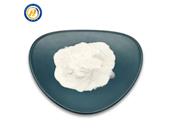
Chemical Name:Desmopressin acetate
Molecular Formula:C<sub>46</sub>H<sub>64</sub>N<sub>14</sub>O<sub>12</sub>S<sub>2</sub>·C<sub>2</sub>H<sub>4</sub>O<sub>2</sub>
CAS:16789-98-3
Molecular Weight:1129.34 g/mol (free base: 1069.24 g/mol)
Appearance:White or almost white powder
Solubility:Freely soluble in water; slightly soluble in ethanol
Stability:Stable at 2–8°C; protect from light and moisture
Mode of Action:Synthetic analog of vasopressin; binds to V<sub>2</sub> receptors to reduce urine output and increase clotting factor VIII.
Pharmacological Use:Treatment of diabetes insipidus, nocturnal enuresis, and hemophilia A/von Willebrand disease (Type I).
Half-life:1.5–2.5 hours (prolonged compared to vasopressin)
Excretion:Primarily renal (unchanged)
Origin:Synthetic peptide (modified vasopressin structure).

Desmopressin acetate is a synthetic peptide hormone analog of vasopressin, designed to enhance antidiuretic effects while minimizing vasopressor activity. It is clinically used for:

| Test Parameter | Specification | Test Method | Reference Standard |
|---|
| Appearance | White or almost white powder | Visual inspection | EP/USP |
| Identification | Complies (HPLC/MS or FTIR) | HPLC/MS or FTIR | EP/USP |
| Assay (HPLC Purity) | 97.0%~103.0% (anhydrous basis) | RP-HPLC (C18 column) | EP/USP |
| Related Substances | Total impurities ≤ 3.0%
Any single impurity ≤ 1.5% | HPLC (gradient elution) | ICH Q3A/B |
| Water Content | ≤ 8.0% (Karl Fischer) | Karl Fischer titration | EP/USP <921> |
| Acetic Acid Content | 5.0%~8.0% (w/w) | Titration/GC | EP |
| Acetate Content | 5.0%~8.0% | Ion chromatography | EP |
| Heavy Metals | ≤ 20 ppm | ICP-MS/USP <231> | EP/USP |
| Microbial Limits | TAMC ≤ 100 CFU/g
TYMC ≤ 50 CFU/g
Absence of specified pathogens | Microbial enumeration | EP/USP <61>, <62> |
| Endotoxin | < 50 IU/mg | LAL test | EP/USP <85> |
| pH (1% solution) | 3.5~5.5 | Potentiometric method | EP/USP <791> |
| Specific Rotation | -70° to -80° (c=1 in water) | Polarimetry | EP/USP <781> |
| Peptide Content | ≥ 90.0% (by amino acid analysis) | Amino Acid Analysis (AAA) | EP |
| Biological Activity | 90%~115% of stated potency | In vitro bioassay (V2 receptor activity) | EP/USP |


 China
China







